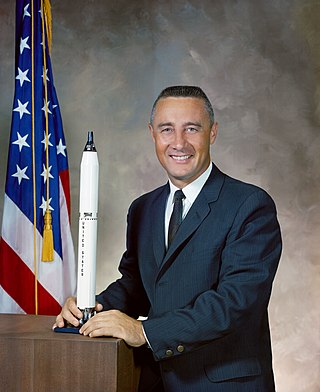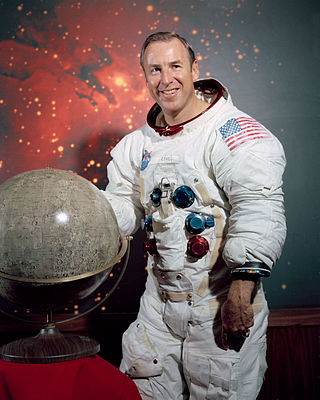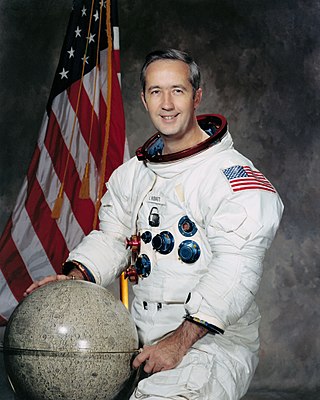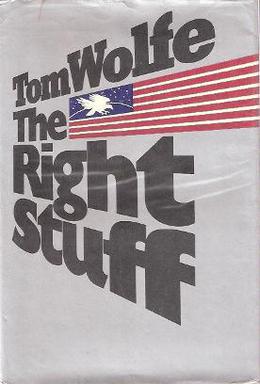Related Research Articles

The Apollo program, also known as Project Apollo, was the United States human spaceflight program carried out by the National Aeronautics and Space Administration (NASA), which succeeded in preparing and landing the first men on the Moon from 1968 to 1972. It was first conceived in 1960 during President Dwight D. Eisenhower's administration as a three-person spacecraft to follow the one-person Project Mercury, which put the first Americans in space. Apollo was later dedicated to President John F. Kennedy's national goal for the 1960s of "landing a man on the Moon and returning him safely to the Earth" in an address to Congress on May 25, 1961. It was the third US human spaceflight program to fly, preceded by the two-person Project Gemini conceived in 1961 to extend spaceflight capability in support of Apollo.

Project Mercury was the first human spaceflight program of the United States, running from 1958 through 1963. An early highlight of the Space Race, its goal was to put a man into Earth orbit and return him safely, ideally before the Soviet Union. Taken over from the US Air Force by the newly created civilian space agency NASA, it conducted 20 uncrewed developmental flights, and six successful flights by astronauts. The program, which took its name from Roman mythology, cost $2.57 billion. The astronauts were collectively known as the "Mercury Seven", and each spacecraft was given a name ending with a "7" by its pilot.

Virgil Ivan "Gus" Grissom was an American engineer and pilot in the United States Air Force, as well as one of the original seven men, the Mercury Seven, selected by the National Aeronautics and Space Administration for Project Mercury, a program to train and launch astronauts into outer space. Grissom was also a Project Gemini and Apollo program astronaut for NASA. As a member of the NASA Astronaut Corps, Grissom was the second American to fly in space in 1961. He was also the second American to fly in space twice, preceded only by Joe Walker with his sub-orbital X-15 flights.

The Space Race was a 20th-century competition between two Cold War rivals, the United States and the Soviet Union, to achieve superior spaceflight capability. It had its origins in the ballistic missile-based nuclear arms race between the two nations following World War II and had its peak with the more particular Moon Race to land on the Moon between the US moonshot and Soviet moonshot programs. The technological advantage demonstrated by spaceflight achievement was seen as necessary for national security and became part of the symbolism and ideology of the time. The Space Race brought pioneering launches of artificial satellites, robotic space probes to the Moon, Venus, and Mars, and human spaceflight in low Earth orbit and ultimately to the Moon.
Human spaceflight programs have been conducted, started, or planned by multiple countries and companies. The age of crewed rocket flight was initiated by Fritz von Opel who piloted the world's first rocket-propelled flight on 30 September 1929. All space flights depend on rocket technology; von Opel was the co-designer and financier of the visionary project. Until the 21st century, human spaceflight programs were sponsored exclusively by governments, through either the military or civilian space agencies. With the launch of the privately funded SpaceShipOne in 2004, a new category of human spaceflight programs – commercial human spaceflight – arrived. By the end of 2022, three countries and one private company (SpaceX) had successfully launched humans to Earth orbit, and two private companies had launched humans on a suborbital trajectory.

Robert Rowe Gilruth was an American aerospace engineer and an aviation/space pioneer who was the first director of NASA's Manned Spacecraft Center, later renamed the Lyndon B. Johnson Space Center.

James Arthur Lovell Jr. is an American retired astronaut, naval aviator, test pilot and mechanical engineer. In 1968, as command module pilot of Apollo 8, he became, with Frank Borman and William Anders, one of the first three astronauts to fly to and orbit the Moon. He then commanded the Apollo 13 lunar mission in 1970 which, after a critical failure en route, looped round the Moon and returned safely to Earth.

From the Earth to the Moon is a twelve-part 1998 HBO television miniseries co-produced by Ron Howard, Brian Grazer, Tom Hanks and Michael Bostick. In docudrama format, it tells the story of the Apollo program during the 1960s and early 1970s. Largely based on Andrew Chaikin's 1994 book, A Man on the Moon, the series is known for its accurate telling of the story of Apollo and the special effects under visual director Ernest D. Farino. The series takes its title from, but is not based upon, Jules Verne's 1865 science fiction novel From the Earth to the Moon.

James Alton McDivitt Jr. was an American test pilot, United States Air Force (USAF) pilot, aeronautical engineer, and NASA astronaut in the Gemini and Apollo programs. He joined the USAF in 1951 and flew 145 combat missions in the Korean War. In 1959, after graduating first in his class with a Bachelor of Science degree in Aeronautical Engineering from the University of Michigan through the U.S. Air Force Institute of Technology (AFIT) program, he qualified as a test pilot at the Air Force Experimental Flight Test Pilot School and Aerospace Research Pilot School, and joined the Manned Spacecraft Operations Branch. By September 1962, McDivitt had logged over 2,500 flight hours, of which more than 2,000 hours were in jet aircraft. This included flying as a chase pilot for Robert M. White's North American X-15 flight on July 17, 1962, in which White reached an altitude of 59.5 miles (95.8 km) and became the first X-15 pilot to be awarded Astronaut Wings.

Project Gemini was the second United States human spaceflight program to fly. Conducted after the first, Project Mercury, and while the Apollo program was still in development, Gemini was conceived in 1961 and concluded in 1966. The Gemini spacecraft carried a two-astronaut crew. Ten Gemini crews and 16 individual astronauts flew low Earth orbit (LEO) missions during 1965 and 1966.
Man In Space Soonest (MISS) was a United States Air Force (USAF) program to put a man into outer space before the Soviet Union. The program was cancelled on August 1, 1958, and was replaced by NASA's Project Mercury. Only two men from the program would actually reach outer space. The first, Joseph A. Walker, did so two or three times in X-15 rocket plane tests in 1963. The other, Neil Armstrong, became a NASA astronaut in 1962, flew on Gemini 8 in 1966, and in 1969 on Apollo 11 becoming the first person to walk on the Moon.

NASA Astronaut Group 2, also known as the Next Nine and the New Nine, was the second group of astronauts selected by the National Aeronautics and Space Administration (NASA). Their selection was announced on September 17, 1962. The group augmented the Mercury Seven. President John F. Kennedy had announced Project Apollo, on May 25, 1961, with the ambitious goal of putting a man on the Moon by the end of the decade, and more astronauts were required to fly the two-man Gemini spacecraft and three-man Apollo spacecraft then under development. The Mercury Seven had been selected to accomplish the simpler task of orbital flight, but the new challenges of space rendezvous and lunar landing led to the selection of candidates with advanced engineering degrees as well as test pilot experience.

NASA Astronaut Group 3—'The Fourteen'—was a group of fourteen astronauts selected by NASA for the Gemini and Apollo program. Their selection was announced in October 1963. Seven were from the United States Air Force, four from the United States Navy, one was from the United States Marine Corps and two were civilians. Four died in training accidents before they could fly in space. All of the surviving ten flew Apollo missions; five also flew Gemini missions. Buzz Aldrin, Alan Bean, Gene Cernan and David Scott walked on the Moon.

Marooned is a 1964 science fiction thriller novel by American writer Martin Caidin, about a crewed spacecraft stranded in Earth orbit, oxygen running out, and only an experimental craft available to attempt a rescue. A film based on the novel led Caidin to prepare a revised version of it in 1968. The film was released in 1969, four months after the Apollo 11 mission, with the revised novel sold by book stores a few weeks earlier.

Glynn Stephen Lunney was an American NASA engineer. An employee of NASA since its creation in 1958, Lunney was a flight director during the Gemini and Apollo programs, and was on duty during historic events such as the Apollo 11 lunar ascent and the pivotal hours of the Apollo 13 crisis. At the end of the Apollo program, he became manager of the Apollo–Soyuz Test Project, the first collaboration in spaceflight between the United States and the Soviet Union. Later, he served as manager of the Space Shuttle program before leaving NASA in 1985 and later becoming a vice president of the United Space Alliance.

The Right Stuff is a 1979 book by Tom Wolfe about the pilots engaged in U.S. postwar research with experimental rocket-powered, high-speed aircraft as well as documenting the stories of the first astronauts selected for the NASA's Project Mercury program. The Right Stuff is based on extensive research by Wolfe, who interviewed test pilots, the astronauts and their wives, among others. The story contrasts the Mercury Seven and their families with other test pilots such as Chuck Yeager, who was never selected as an astronaut.

When We Left Earth: The NASA Missions is a 2008 Discovery Channel HD documentary miniseries consisting of six episodes documenting American human spaceflight from the first Mercury flights and the Gemini program, to the Apollo program and its Moon missions and landings, to the Space Shuttle missions and the construction of the International Space Station.
Moon Machines is a Science Channel HD documentary miniseries consisting of six episodes documenting the engineering challenges of the Apollo program to land men on the Moon. It covers everything from the iconic Saturn V to the Command Module, the Lunar Module, the Space Suits, the Guidance and Control Computer, and the Lunar Rover. It was created by the team that made In the Shadow of the Moon in association with NASA to commemorate the agency's fiftieth anniversary in 2008. It first aired in June 2008 in the U.S. and UK, and was released on DVD a year later in June 2009.
With the advent of robotic and human spaceflight a new era of American history had presented itself. Keeping with the tradition of honoring the country's history on U.S. postage stamps, the U.S. Post Office began commemorating the various events with its commemorative postage stamp issues. The first U.S. Postage issue to depict a U.S. space vehicle was issued in 1948, the Fort Bliss issue. The first issue to commemorate a space project by name was the ECHO I communications satellite commemorative issue of 1960. Next was the Project Mercury issue of 1962. As U.S. space exploration progressed a variety of other commemorative issues followed, many of which bear accurate depictions of satellites, space capsules, Apollo Lunar Modules, space suits, and other items of interest.
References
- ↑ Toronto Star
- ↑ REMI Award Winners at Worldfest Archived 2016-01-26 at the Wayback Machine
- ↑ Spider Robinson Online Diary